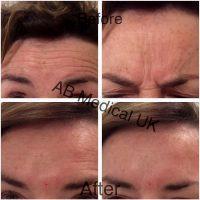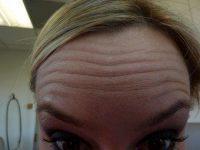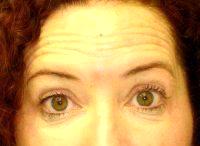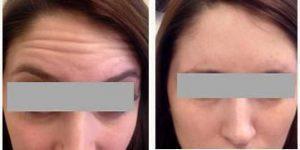How Long Should Botox Last In Forehead?
Botox lasts 3 – 6 months depending on the area and many other factors
Generally Botox lasts a little longer in the forehead and armpits (for excessive sweating) – say 5 months, than in the crow’s feet – about 3 months.
Other factors also are important such as the dose, the freshness, the precision of injection, and the overall health and age of the person.
Some think that exercise of the muscles shortens the effect.
Others think in the very first days it enhances uptake of the botox into the muscle and improves its effects. (Christopher J. Peers, MD, South Bend Facial Plastic Surgeon)
In general, expect the injection to last 3 to 4 months. It does depend on the dose and site of injection. In the frown line, smile lines around the eyes (“crow feet”), and in the forehead, 3 to 4 months is realistic.
I do more advanced injection in other sites (like the lips and neck) that have different length of effect.
Also, some of my patients that have been getting botox in the glabella for the frown for longer than 6 to 10 years only need touch ups every 6 to 8 months. (Myriam Loyo, MD, Portland Facial Plastic Surgeon)
In general, Botox lasts 3-4 months. The object is to balance the muscles of the forehead so that they are not pulling against each other. This usually requires placing Botox between the eyebrows, in the muscles of the forehead and along the outer orbit or in the crows feet region.
If you keep the muscles weak for the first year by having Botox every 3-4 months the rested look around the eyes and forehead will last longer. This is due to training the muscles to work together. (Jeffrey S. Rosenthal, MD, Fairfield Plastic Surgeon)
Botox typically lasts 3-4 months
Botox typically lasts 3-4 months, at which time your muscles in that area of the face start moving again and it is time for your next treatment! (Jennifer L. Walden, MD, Austin Plastic Surgeon)
How long does Botox last?
The amount of Botox injected correlates with how long the effects last. Some areas are best treated with smaller amounts of Botox, to prevent side-effects and get the best results – such as the lines across the forehead.
These areas will need re-treatment with botox every 3-4 months. The effect lasts longest for the frown lines which are treated with a higher dose of Botox. The effect for the frown lines may last from 3 to 9 months. (Renuka Diwan, MD, Cleveland Dermatologic Surgeon)
Botox for facial rhytids
Botox is a fantastic treatment for wrinkles in several areas of the face including the glabellar region (between the brows), the forehead, and the periorbital region (crows feet). The length of the effect is somewhat variable but is usually in the 3-4 month range.
In some people the effect can last as short as 2 months or as long as 6 months. The rate at which it wears off is dependent on how fast your body replaces the blocked neurotransmitter receptors. (Derek Rapp, MD, Richardson Physician)
Botox/Dysport generally last approximately 3 months. For some, they last longer and for others they the effects may dissipate after just a few months. The key to improving wrinkles and fine lines is to consistently keep the muscles causing these wrinkles relaxed.

Botox Forehead Before After Pic
It’s therefore best to have your botox done when you start noticing movement of the muscles and not wait until they’ve regained full function. (Ava Shamban, MD, Santa Monica Dermatologic Surgeon)
In general, expect the injection to last 3 to 4 months. It does depend on the dose and site of injection. In the frown line, smile lines around the eyes (“crow feet”), and in the forehead, 3 to 4 months is realistic.
I do more advanced injection in other sites (like the lips and neck) that have different length of effect.
Also, some of my patients that have been getting botox in the glabella for the frown for longer than 6 to 10 years only need touch ups every 6 to 8 months. (Myriam Loyo, MD, Portland Facial Plastic Surgeon)
Many factors determine the length of duration of Botox, but in general patients can expect to see results for 3-4 months. The longer one uses Botox, the longer a particular dose tends to last. That said, variability will exist even in the same patient, as areas that typically move more (lets say the mouth versus the forehead) will have a return of wrinkles sooner, as will the wrinkles that are caused by larger muscles than those created by smaller muscles. (Nelson Castillo, MD, Atlanta Plastic Surgeon)

Doctor Samantha Toerge, MD, Chevy Chase Dermatologic Surgeon – Botox- Forehead
Botox and dysport typically last about 4 months however I have seen cases that lasted only 3 months and one case lasting9 months .if someone has better developed muscles or if not enough product was used it could lead to less of an effect of the botox or of the dysport (Joshua L. Fox, MD, Long Island Dermatologic Surgeon)
Botox dose affects results.
Botox on average typically lasts 3-4 months. How long it lasts, however, depends on a variety of issues. First and foremost is every patient is different. I have had patients coming to me for years for Botox who still, unfortunately, need it every three months.
Others, whether it be the first time or their tenth time, will find that they need it less often, sometimes as infrequently as every 6-8 months. In addition, what dose is used definitely affects how long it lasts.

Dr A. H. Nezami, MD, Jacksonville Plastic Surgeon – Forehead Lines
Using a dose to just relax the muscles will often mean less longer lasting results. A more complete freeze of the muscles can lead to longer lasting results. What is great about Botox is that, fortunately, treatments are usually a minimal down time procedure with many patients doing it over their lunch.
Botox is a great option for those looking to tweak their appearance with almost no down time. (Mark Hamilton, MD, Indianapolis Facial Plastic Surgeon)
Botox acts to prevent nerves from stimulating muscles. This molecular effect wears off in 3 months. If used repeatedly every three months, the underlying muscle weakens (atrophies) and the weakness last longer and longer after each treatment. (Martin Jugenburg, MD, Toronto Plastic Surgeon)
Botox is a muscle toxin that prevents a neurochemical from stimulating the muscle to contract. In the face, the muscles of facial expression that contract over years eventually wrinkle the skin. By relaxing the muscle, botox can temporarily eliminate the wrinkle and rejuvenate the skin.

Doctor Jason Emer, MD, Los Angeles Dermatologic Surgeon – 30 Year Old Male Treated For Forehead Lines
Patients tend to respond in varying degrees to Botox. The average patient will have a 3 – 5 day onset and the Botox will last an average of 3 – 4 months. The effects will gradually wear off over this time period.
Some patient do appear more sensitive to Botox and will go 6 months or longer between treatment while other patients will need retreatment sooner than 3 months. The amount of product needed also varies from patient to patient.
An average treatment for the forehead and glabella will range from 24 to 50 units. (John L. Burns Jr., MD, Dallas Plastic Surgeon)
As a general rule, Botox lasts approximately 2 to 3 months for men and 3 to 4 months for women. There is some inivudal variation but in my experience there is no certain way to predict whether or not you’ll be a longer or shorter responder to the effects of Botox. (Deason Dunagan, MD, Huntsville Plastic Surgeon)
our practice helps patients to get an appointment for about 4 months after the treatment since we know it will start to fade at about that time. Some patients it last a little longer and some a little longer but this is the most common length of time.
Since it often takes time to determine how much botox a person might need, we offer free touch ups for botox if done in the first month after receiving the treatment. (Manish Raj Gupta, MD, Toledo Plastic Surgeon)
Assuming that there is no degradation of the Botox during shipping, storage and reconstitution, Botox lasts between 3-4 months on average. This varies depending on the volume, strength and dynamic of the muscle and how efficient the body degrades the Botox protein.
For example, in a younger patient, where the muscle may be thicker, stronger and more dynamic, Botox may not last four months. On the other hand, in an older patient, where the muscle may be thinner, weaker and less dynamic, Botox may last longer than four months. (Laura Phan, MD, Los Gatos Physician)


